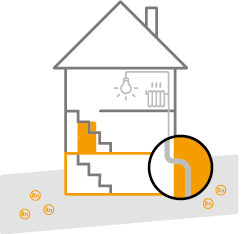Precaution for new construction
Simple precautionary measures can prevent elevated radon concentrations in new buildings.
New buildings should be planned in such a way that the average annual radon concentration in the occupied rooms is well below 300 becquerels per cubic meter. To ensure this, a convection-tight design of the building components, connections and penetrations in contact with the ground is essential.
In most cases, high indoor radon concentrations can be avoided by properly sealing the building from the ground. In certain areas, further simple measures (installation of a radon drainage system) may be necessary. This is especially true if a convection-tight design of the building components cannot be guaranteed or if the building site is located in a radon protection area.
ÖNORM
The ÖNORM S 5280-2 "Radon - Structural precautionary measures in buildings" describes the required radon protection measures and applies to the planning and construction of new buildings and extensions intended for residential, work and residence purposes. It also applies to renovations in which horizontal components in contact with the ground are rebuilt down to the ground.
The scope of the radon protection measures depends on the area designation according to the radon map, the type of building (construction of the components in contact with the ground or basement) and on the use (lounges planned in the basement area).
According to ÖNORM S 5280-2, buildings that are sealed against non-pressing or pressing water and have convection-tight connections and penetrations are in any case sufficiently sealed against radon convection. The following are examples of convection-tight designs for building components in contact with the ground:
- Execution according to ÖBV guideline "Water Impermeable Concrete Structures - White Tubs" in requirement class AS or A1.
- Execution according to ÖNORM B 3692 for the load case of non-pressing or pressing water.
Caution: The points listed above are examples. A deviation is possible if the convection-tight design of the components in contact with the ground according to ÖNORM (load case non-pressing or load case pressing water) is fully complied with.
Furthermore, the following construction is sufficiently tight against radon convection:
Continuous foundation slab with a thickness of at least 20 cm in combination with convection-tight pipe and line penetrations (e.g. sewage pipe, electrical lines). If vertical or horizontal concrete components in contact with the ground adjoin the foundation slab, convection tightness must be permanently ensured with a joint sealing tape or an equivalent measure.
If a convection-tight design of the components in contact with the ground is not possible or the building ground is located in a radon protection area, the installation of a radon drainage system with passive air removal must be provided. If such a measure is already taken into account during new construction, the additional costs are low and usually range between 500 and 2000 euros.
In addition, simple sealing measures should be provided for existing areas in contact with the ground (e.g. cellars and basements) in the interests of optimization.
Basement
If the building has a basement and no occupied rooms are planned in the basement, appropriate sealing measures between the basement and the first floor can prevent the spread of radon within the building. Such sealing measures include sealing of ducts and shafts as well as all penetrations through the basement ceiling. In addition, the installation of a self-closing basement door that inhibits convection towards the occupied area is recommended. Such measures are at best also useful as supplementary radon protection measures in the sense of optimization. After completion of the building, a control measurement of the radon concentration is recommended.
The province of Upper Austria has published a brochure on the subject, which discusses implementation details for radon drainage as well as the other options mentioned above.
In any case, precautionary measures are simpler, more efficient to implement and certainly less expensive than any radon remediation measures that may be required later. Soil gas investigations on the building ground are not recommended, as they are time-consuming, expensive and not meaningful and also do not cancel an existing area designation as e.g. a radon precautionary area, even with low measured values.
Subsidies
Under certain conditions, the province of Upper Austria subsidizes radon precautionary measures in new buildings.
